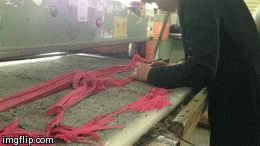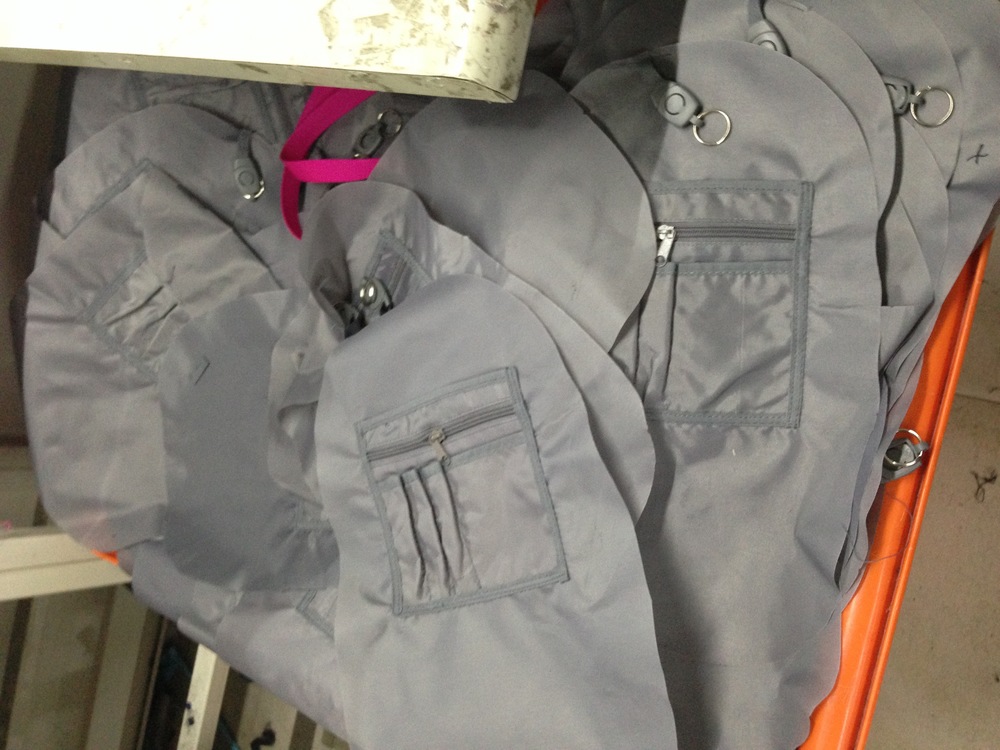How are rucksacks made? Step by step manufacturing process

www.riut.co.uk I'm sharing the manufacturing process soon to come for the RiutBag just funded on Kickstarter. I recently visited the factory in China I'm using to get my bags made to send to my backers. I want to show my Kickstarter backers how much work goes into making their product from start to finish. Of course, it's not just the RiutBag. All the textiles products we own have been constructed by people in factories somewhere. It's a good reminder, I feel, to see how much time, effort and skill makes our products possible.
It's people - I'd say 11 per bag - who make the RiutBag and all other textile rucksacks or backpacks you see lined up identically in shops, on fellow travellers backs and the one on yours. They aren't made by machine. Your current rucksack has been in the hands of many people: those who make the material, shift rolls of material into trucks and deliver them to the factory. I'm going to show you the steps to making a bag once my factory has all the material it needs.
Cutting material
Once the factory has created its final manufacturable version of the RiutBag, it knows how much of each piece of material it requires. This means it can put in an order with each of the material manufacturers and have that amount delivered to the factory. Using their final manufacturable version of the RiutBag, they know what each of the pattern pieces needs to look like too.
I'm ordering 1300 RiutBags. This is absolute minimum order, which allows us to place orders with the manufacturers. Starting with hundreds of yards of each material, the factors has different sized cutting moulds prepared. At least 1,300 of each piece will be cut.
It's difficult for us to imagine the process required to make 1,300 rucksacks. That's 2,600 straps each of which is made of 17 pieces - 44,200 pieces in total just to make the straps! - and 13,000 zip pulls, for instance. So if there are 80 pieces which make up each RiutBag, that's 104,000 pieces in total to cut and collect.
Using this mould, it's placed over hundreds of layers of each piece of fabric required for the given bag design. The mould is placed on by hand and a machine is used to press the mould over the material to cut it, one shape at a time. Here's one of the factory's cutters using the machine. On the day I visited, only the cutting machine was being used. However, when required, tens of production line cutters will cut pieces by hand if required.
Embroidery + printing
All the details on the fabric you see - embroidered logos, panels, designs or prints - must be added after the material is cut and before the pattern pieces make their way to the production line stitchers.
Piles of cut material make their way up to production line to begin being sewn into individual parts of the bag. One or two people are given the design, they practice it under instruction of the production line manager and then make as many as is required.
In the case of the RiutBag, the front panel is embroidered with the Riut logo. This will be embroidered by machine on to 1300 panels by one or two people. The same goes for the printed logo on the inside tablet holding panel.
Once they are ready all material is stacked and moved to the production line.
Sewing smaller components
I had previously thought that one bag is made by one person. That's not the case; here's the updated version.
Thinking about a rucksack like the RiutBag, there are some individual pieces which must be made first before the whole RiutBag is constructed by one person. Each strap - made of about 13 pieces in the case of the RiutBag - must be constructed first. So one person has the task of learning to make, refining their approach, testing and then creating 100 to 200 components each day.
Unless the design lends itself to doing two processes in one, the person will systematically do one process at a time. 1) Sew inner foam to mesh padding; 2) sew foam/mesh padding to outer Cordura; 3) sew adjustable chest strap holder to rest of strap; 4) attach glider; 5) sew binding on to outer Cordura panel; 6) sew outer Cordura panel on to rest of strap as so on. This is to make one component.
Other components on the RiutBag which must be finished before final construction include the large padded strap at the top of the RiutBag, bottle holder compartments and the three-compartment laptop holder.
Main bag construction
This is the bit that one person does. A single person takes all of the components and builds them step by step into one bag. Depending on the size of the order, there maybe one or many people completing this stage.
 At the beginning, you've got pretty small piles of flat components lying around. But once you're at this stage, the thing you're producing by the end of each process is pretty huge! Any something I wasn't expecting was seeing these larger bags flying around the room! So the piles of finished productions is a small mountain. That means a smaller number of bags is practical to handle at any one time. For a medium sized rucksack like the RiutBag, no more than 40 can go through this final process by one person before being finished.
At the beginning, you've got pretty small piles of flat components lying around. But once you're at this stage, the thing you're producing by the end of each process is pretty huge! Any something I wasn't expecting was seeing these larger bags flying around the room! So the piles of finished productions is a small mountain. That means a smaller number of bags is practical to handle at any one time. For a medium sized rucksack like the RiutBag, no more than 40 can go through this final process by one person before being finished.
Quality control
One person takes the final version, cuts off all the individual threads sticking out and tests the bag. The bag is turned inside out to inspect each seam, the finish on zips and corners. Having to cut the threads off the bag all over gives this person the perfect reason to look at every seam, nook and crannie.
 You might think this is an impossible task for one human to do; but once you've done one of two bags your eyes start seeing differences very quickly. Anything that looks out of place might be invisible to a consumer, like us, who hasn't seen 100 others, but to this quality control and thread checker the design is imprinted on their mind for this production run.
You might think this is an impossible task for one human to do; but once you've done one of two bags your eyes start seeing differences very quickly. Anything that looks out of place might be invisible to a consumer, like us, who hasn't seen 100 others, but to this quality control and thread checker the design is imprinted on their mind for this production run.
Finally, they are counted, stacked and sent to the packing room.
Packing
When your bag is completed it makes one more trip in the factory. It's counted, put into its own protective packaging and a carton - cardboard box - for shipping.
One person does each of these steps. Of all the rooms in the factory, this rom had the least bustle. Here, a smaller number of people were completing their individual tasks quietly and relatively slowly. It was a muted end to a process of many parts. But it seems to be working.
That's it! These are the broad steps your RiutBag will go through to be completed at this factory.
Please contact me on www.facebook.com/riutbag to ask questions on this blog. I'm happy to expand on this if you have questions. As I understand more about the process, I'll be updating you here.
www.riut.co.uk







